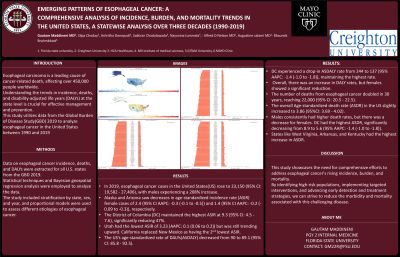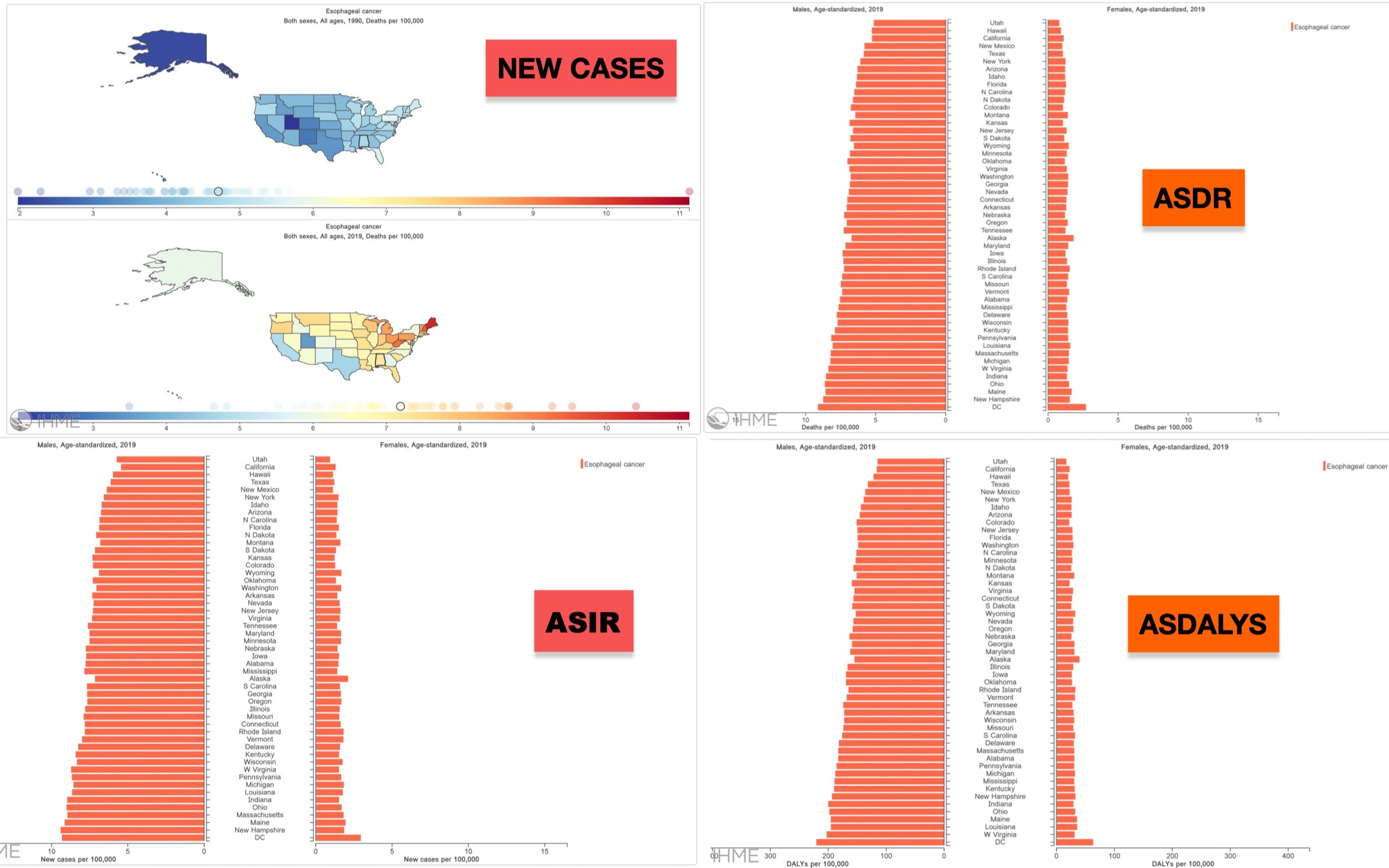Sunday Poster Session
Category: Esophagus
P0428 - Emerging Patterns of Esophageal Cancer: A Comprehensive Analysis of Incidence, Burden, and Mortality Trends in the United States, a Statewise Analysis over Three Decades (1990-2019)
Sunday, October 22, 2023
3:30 PM - 7:00 PM PT
Location: Exhibit Hall

Has Audio
- AD
Ashrita Donepudi, MD
HCA Healthcare
Las Vegas, NV
Presenting Author(s)
Gautam Maddineni, MD1, Silpa Choday, MD2, Ashrita Donepudi, MD3, Sai Kiran Chadalawada, MBBS4, Nayanika Tummala, MBBS5, Alfred Nelson, MBBS6, Augustine Salami, MD1, Bhaumik Brahmbhatt, MBBS7
1Florida State University, Cape Coral, FL; 2Creighton University, Phoenix, AZ; 3HCA Healthcare, Las Vegas, NV; 4NRI Institute of Medical Sciences, Cape Coral, FL; 5GIMSR Medical College, Cape Coral, FL; 6AdventHealth, Orlando, FL; 7Mayo Clinic, Jacksonville, FL
Introduction: Esophageal carcinoma is a leading cause of cancer-related death, affecting over 450,000 people worldwide. Understanding the trends in incidence, deaths, and disability-adjusted life years (DALYs) at the state level is crucial for effective management and prevention. This study utilizes data from the Global Burden of Disease Study(GBD) 2019 to analyze esophageal cancer in the United States between 2010 and 2019.
Methods: Data on esophageal cancer incidence, deaths, and DALYs were extracted for all U.S. states from the GBD 2019. Statistical techniques and Bayesian geospatial regression analysis were employed to analyze the data. The study included stratification by state, sex, and year, and proportional models were used to assess different etiologies of esophageal cancer.
Results: In 2019, esophageal cancer cases in the United States(US) rose to 23,150 (95% CI: 19,582 - 27,406), with males experiencing a 208% increase. Alaska and Arizona saw decreases in age-standardized incidence rate (ASIR) female cases of 2.4 (95% CI AAPC: -0.3 (-0.1 to -0.5)) and 1.4 (95% CI AAPC: -0.2 (-0.09 to -0.3)), respectively. The District of Columbia (DC) maintained the highest ASIR at 9.3 (95% CI: 4.5 - 7.6), significantly reducing 47%. Utah had the lowest ASIR of 3.23 (AAPC: 0.1 (0.06 to 0.2)) but was still trending upward. California replaced New Mexico as having the 2nd lowest ASIR. The US's age-standardized rate of DALYs(ASDALY) decreased from 90 to 89.1 (95% CI: 85.8 - 92.5). DC experienced a drop-in ASDALY rate from 244 to 137 (95% AAPC: -1.4 (-1.0 to -1.8)), maintaining the highest rate. Overall, there was an increase in DALY rates, but females showed a significant reduction. The number of deaths from esophageal cancer doubled in 30 years, reaching 22,000 (95% CI: 20.5 - 22.5). The overall Age-standardized death rate (ASDR) in the US slightly increased to 3.86 (95% CI: 3.69 - 4.02). Males consistently had higher death rates, but there was a decrease for females. DC had the highest ASDR, significantly decreasing from 8.9 to 5.6 (95% AAPC: -1.4 (-1.0 to -1.8)). States like West Virginia, Arkansas, and Kentucky had the highest increase in ASDR.
Discussion: This study showcases the need for comprehensive efforts to address esophageal cancer's rising incidence, burden, and mortality. By identifying high-risk populations, implementing targeted interventions, and advancing early detection and treatment strategies, we can strive to reduce the morbidity and mortality associated with this challenging disease.

Disclosures:
Gautam Maddineni, MD1, Silpa Choday, MD2, Ashrita Donepudi, MD3, Sai Kiran Chadalawada, MBBS4, Nayanika Tummala, MBBS5, Alfred Nelson, MBBS6, Augustine Salami, MD1, Bhaumik Brahmbhatt, MBBS7. P0428 - Emerging Patterns of Esophageal Cancer: A Comprehensive Analysis of Incidence, Burden, and Mortality Trends in the United States, a Statewise Analysis over Three Decades (1990-2019), ACG 2023 Annual Scientific Meeting Abstracts. Vancouver, BC, Canada: American College of Gastroenterology.
1Florida State University, Cape Coral, FL; 2Creighton University, Phoenix, AZ; 3HCA Healthcare, Las Vegas, NV; 4NRI Institute of Medical Sciences, Cape Coral, FL; 5GIMSR Medical College, Cape Coral, FL; 6AdventHealth, Orlando, FL; 7Mayo Clinic, Jacksonville, FL
Introduction: Esophageal carcinoma is a leading cause of cancer-related death, affecting over 450,000 people worldwide. Understanding the trends in incidence, deaths, and disability-adjusted life years (DALYs) at the state level is crucial for effective management and prevention. This study utilizes data from the Global Burden of Disease Study(GBD) 2019 to analyze esophageal cancer in the United States between 2010 and 2019.
Methods: Data on esophageal cancer incidence, deaths, and DALYs were extracted for all U.S. states from the GBD 2019. Statistical techniques and Bayesian geospatial regression analysis were employed to analyze the data. The study included stratification by state, sex, and year, and proportional models were used to assess different etiologies of esophageal cancer.
Results: In 2019, esophageal cancer cases in the United States(US) rose to 23,150 (95% CI: 19,582 - 27,406), with males experiencing a 208% increase. Alaska and Arizona saw decreases in age-standardized incidence rate (ASIR) female cases of 2.4 (95% CI AAPC: -0.3 (-0.1 to -0.5)) and 1.4 (95% CI AAPC: -0.2 (-0.09 to -0.3)), respectively. The District of Columbia (DC) maintained the highest ASIR at 9.3 (95% CI: 4.5 - 7.6), significantly reducing 47%. Utah had the lowest ASIR of 3.23 (AAPC: 0.1 (0.06 to 0.2)) but was still trending upward. California replaced New Mexico as having the 2nd lowest ASIR. The US's age-standardized rate of DALYs(ASDALY) decreased from 90 to 89.1 (95% CI: 85.8 - 92.5). DC experienced a drop-in ASDALY rate from 244 to 137 (95% AAPC: -1.4 (-1.0 to -1.8)), maintaining the highest rate. Overall, there was an increase in DALY rates, but females showed a significant reduction. The number of deaths from esophageal cancer doubled in 30 years, reaching 22,000 (95% CI: 20.5 - 22.5). The overall Age-standardized death rate (ASDR) in the US slightly increased to 3.86 (95% CI: 3.69 - 4.02). Males consistently had higher death rates, but there was a decrease for females. DC had the highest ASDR, significantly decreasing from 8.9 to 5.6 (95% AAPC: -1.4 (-1.0 to -1.8)). States like West Virginia, Arkansas, and Kentucky had the highest increase in ASDR.
Discussion: This study showcases the need for comprehensive efforts to address esophageal cancer's rising incidence, burden, and mortality. By identifying high-risk populations, implementing targeted interventions, and advancing early detection and treatment strategies, we can strive to reduce the morbidity and mortality associated with this challenging disease.

Figure: IMAGE WITH STATEWIDE COMPARISON OF THE NUMBER OF CASES, ASIR, ASDALYS, AND ASDR.
Disclosures:
Gautam Maddineni indicated no relevant financial relationships.
Silpa Choday indicated no relevant financial relationships.
Ashrita Donepudi indicated no relevant financial relationships.
Sai Kiran Chadalawada indicated no relevant financial relationships.
Nayanika Tummala indicated no relevant financial relationships.
Alfred Nelson indicated no relevant financial relationships.
Augustine Salami indicated no relevant financial relationships.
Bhaumik Brahmbhatt indicated no relevant financial relationships.
Gautam Maddineni, MD1, Silpa Choday, MD2, Ashrita Donepudi, MD3, Sai Kiran Chadalawada, MBBS4, Nayanika Tummala, MBBS5, Alfred Nelson, MBBS6, Augustine Salami, MD1, Bhaumik Brahmbhatt, MBBS7. P0428 - Emerging Patterns of Esophageal Cancer: A Comprehensive Analysis of Incidence, Burden, and Mortality Trends in the United States, a Statewise Analysis over Three Decades (1990-2019), ACG 2023 Annual Scientific Meeting Abstracts. Vancouver, BC, Canada: American College of Gastroenterology.
